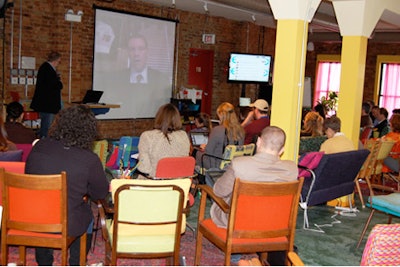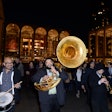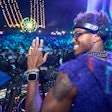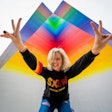
The EventCamp National Conference took place at Chicago's Catalyst Ranch from Friday through Sunday. With an opening night cocktail party followed by two days of educational sessions, the conference let planners explore the ways technology and other new engagement tools are adding value to events—and have potential to add even more. A main theme was that while existing social media help broaden an event's reach, future developments should focus on making events more valuable to live attendees, virtual participants, and sponsors.
Paul Salinger, vice president of marketing at Oracle, led a general session on "Social Casting," or the integration of social media and live events. Using Oracle's 40,000-guest OpenWorld conference as an example, Salinger said that actions such as as live-streaming the conference's keynote speeches onto Oracle's Web site and allowing followers to tweet questions have become basic ways to engage remote attendees.
Future measures to engage virtual OpenWorld guests, Salinger said, may include creating a video wall that showcases photos and bios of each remote participant, and assigning staff to assist the virtual guests. "But what more can we do?" he asked the audience, who then broke into groups to discuss their own ideas on the topic.
Suggestions included creating hybrid-event concierge positions within companies or providing virtual event attendees with exclusive offers. "It's rare to meet all the senior-level people you want to at a 4,000-guest event," one guest pointed out. "So a perk for virtual attendees may be to have exclusive one-on-one meet-and-greets online with certain executives."
Other suggestions included hosting contests for virtual attendees before an event, in which winners would get a sponsored hybrid-event-viewing party in their local cities. "So if 10 people in Romania want to watch, they can follow the event's content and also get in some networking," Salinger said.
Appropriately, Salinger's session was live-streamed via the EventCamp Web site, and remote followers could tweet suggestions. A staffer with a laptop and a microphone read some of the Twitter feedback to the crowd at Catalyst Ranch.
In the conference's closing session, dubbed "Event Immersion: Where Do We Go From Here?" Oklahoma-based technology speaker Scott Klososky addressed the ways in which future event technologies can add value for sponsors. Via Skype, Klososky suggested that technology should be capable of evaluating event attendees based on their titles and places of business, and that virtual alerts should be sent to sponsors when a particular guest enters an event.
For example, the standard trade show model of having a company sponsor a booth and assuring the sponsor that all trade show attendees will pass by that booth "is crude," Klososky said. He said there should be technology that alerts a sponsor when a particularly influential attendee, or a rep from a company of interest, passes by.
Klososky also suggested that event attendees should get alerts to keep them apprised about a particular subject. "Some meetings have three sessions going on at the same time, and it's impossible for one guest to get to them all," he pointed out. In Klososky's proposed technology, systems would alert attendees when specific topics of interest came up in sessions, and send any materials—such as Word documents or PowerPoint presentations—to the device of the attendee's choosing.
"I'm very sure that we're going to get to the world I'm painting," said Klososky. "Four years ago I mentioned Twitter in a presentation, and the audience looked at me like I was crazy."
Correction: The original version of this article incorrectly reported that Oracle's OpenWorld conference has 4,000 attendees. In fact, the conference draws 40,000.



















